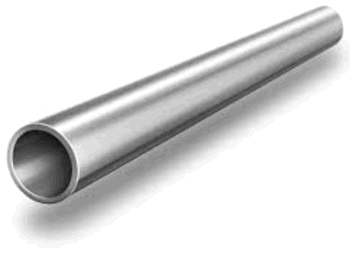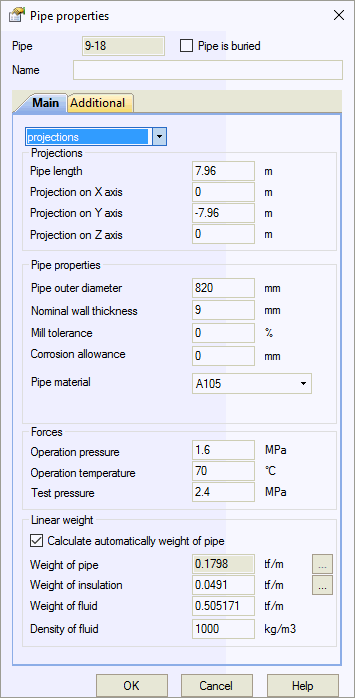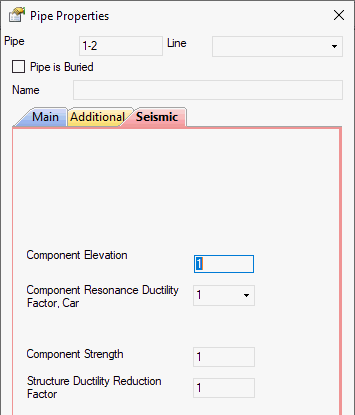

Tabs:

To insert the pipe you must select the node that will be start node of the pipe element and then insert the pipe in that node. The end node will be created automatically if it was not specified. To insert the pipe between two existing nodes you must select these nodes and then insert the pipe element between them or specify the node numbers manually.
Property |
Description |
Name |
Text field. Element can be sorted by name and selected in the project tree |
Projections\sphere\cylinder1 |
Element dimensions in space can be input in five ways:
|
External diameter, D |
External pipe diameter, D |
Pipe length |
Pipe element length
|
Real length |
Real pipe length
|
Manufacturing technology |
For ASME B31.1, ASME B31.3, DL/T 5366-2014 seamless pipe will always use Wl=1.0. For electric-welded pipe Wl will be specified from database. More... When using GOST 32388-2013, pipe physical properties are taken from different materials databases depending on pipe type (seamless/welded). |
Material |
Material from materials database |
Nominal wall thickness, S |
Nominal (actual) wall thickness |
Mill tolerance |
Mill tolerance at the time of production. More... |
Liner thickness, tL |
Thickness of the liner (internal protective layer) for FRP piping. Liner and Topcoat thickness are used to calculate reinforced wall thickness tr=t-tL-tc and mean diameter Dr=D-2*tc-tr
|
Topcoat thickness, tc |
Thickness of the topcoat (external protective layer) for FRP piping |
Corrosion and wear allowance |
Corrosion and wear allowance (working mill tolerance) for wall thickness. More... |
Pressure, P |
Design pressure set for all standards except SNIP 2.05.06-85 and SP 36.13330.2012. Operation pressure set when analyzing with SNIP 2.05.06-85 and SP 36.13330.2012. This
property can be changed in different operation
modes. To see the value of this property in all operating
modes push the |
Temperature, Тop |
Design temperature in operating mode. More... This
property can be changed in different operation
modes. To see the value of this property in all operating
modes push the |
Thermal Gradient |
Thermal gradient is the temperature difference between the bottom and the top of the pipe dT=Ttop-Tbottom. Used to model thermal bowing effect on horizontal pipes. More... To
see the value of this property in all operating modes push the
|
Installation pressure, Passembly |
Pressure in installation state. See "wall thickness analysis" |
Automatic pipe weight calculation |
Pipe weight is automatically calculated as
Material density is taken from the materials database |
Uniform pipe weight |
Uniform pipe and adjoining structure weight. More... |
Uniform insulation weight |
Uniform insulation weight. More... This
property can be changed in different operation
modes. To see the value of this property in all operating
modes push the |
Insulation Thickness, ti Insulation Density Cladding Thickness, tc Cladding Density Lining Thickness, tl Lining Density |
1 - pipe, 2 - insulation, 3-cladding, 4 - lining, t - pipe wall thickness, ti - insulation thickness, tc - cladding thickness, tl - lining thickness
|
Uniform product weight / product density |
Uniform product weight or product density. More... This
property can be changed in different operation
modes. To see the value of this property in all operating
modes push the |

Property |
Description |
Longitudinal Weld Joint Efficiency Factor, E |
Longitudinal weld joint efficiency factor, E. More... |
Coefficient y |
For B31.3 code, the coefficient depending on temperature and steel type
|
Design Factor, F |
For ASME B31.8 Onshore:
For ASME B31.12PL:
|
Design Factor, a |
For BS PD 8010 Onshore:
|
Location Factor, L |
For CSA Z662: Table 4.2
|
Basic Design Factor, FA, FB |
For CSA Z662: Table 11.1
|
Steel Performance Factor, Mf Steel Performance Factor, Hf |
ASME B31.12:
|
High Pressure |
If this option is checked, then used Chapter IX requirements of ASME B31.3 |
Pipeline Location |
If checked Offshore Pipeline, then used Chapter IX requirements of ASME B31.4 or Chapter VIII requirements of ASME B31.8 If checked Slurry Pipes, then used Chapter XI requirements of ASME B31.4 |
Pipeline Type |
Restrained Pipeline - for this pipe will be used code requirements as for restrained pipe. See details here. Unrestrained Pipeline - for this pipe will be used code requirements as for unrestrained pipe. See details here. Riser or Platform for Inland Waterways or Platform Piping - for this pipe will be used code requirements as for Riser If you don't want to specify manually restrained and unrestrained pipes, just select Autodetect or START Smart Check options in Project Settings. See details here. |
Creep diminish factor2, |
Compensation stress averaging factor.
Input only for high-temperature
pipelines according
to RD 10-249-98 section
5.2.3.6, GOST 32388-2013 section
7.1.7. Input 0 for low-temperature
pipelines. Can be calculated
automatically by clicking |
Creep self-springing factor2,
|
Compensation stress relaxation factor.
Input only for high-temperature
pipelines according
to RD 10-249-98 section 5.2.3.7, GOST
32388-2013 section 7.1.7. Input
0 for low-temperature pipelines. Can
be calculated automatically by clicking |
Pipeline category |
Pipeline category according to SNIP 2.05.06-85 table 1: B, I, II, III, IV. Used for calculating the operation condition factor m |
Product |
Product: gas, oil, oil products. Used for calculating the safety factor based on pipeline function using SNIP 2.05.06-85 |
Safety factor K1 |
Safety factor for material K1 according to SNIP 2.05.06-85 table 9 |
Safety factor K2 |
Safety factor for material K2 according to SNIP 2.05.06-85 table 10 |
Safety factor based on load n for internal pressure |
Safety factor based on load n for internal pressure according to SNIP 2.05.06-85 table 13 |
Safety factor, Ky |
Used for plastic piping (HDPE piping). Should be provided by pipe manufacturer. In absence of the data the table below may be used. See Thermoplastic Piping Stress Analysis
|
Chemical resistance factor, A2 |
Used for FRP/GRP/GRE piping. In case of non-aggressive product the factor is 1.0 |
Chemical resistance factor, Kx |
Used for plastic piping (HDPE piping). In case of non-aggressive product the factor is 1.0. The factor should be provided by pipe manufacturer. See Thermoplastic Piping Stress Analysis |
Laying condition factor, Kp |
Used for plastic piping. The decision can be made by stress analyst
|
Temperature range factor, k |
Used for plastic and fiberglass piping. The temperature range is multiplied by this factor. It consider the nonlinear distribution of temperature across the wall thickness. For thermoplastic piping recommended value is 1.0 and for fiberglass piping 0.85 for fluid and 0.8 for gas if no other information available. See Thermoplastic Piping Stress Analysis |
Swelling strain, e3 |
Used for plastic piping. Should be provided by pipe manufacturer. See Thermoplastic Piping Stress Analysis |
Strength factor of joint, Кс |
Used for plastic piping. Should be provided by pipe manufacturer. In absence of the data the table below may be used. See Thermoplastic Piping Stress Analysis
|
Safety Factor gm |
Used in EN 13941:
|
Project Class |
Used in EN 13941: Class A, B, C can be specified manually. Or you can choose Auto option. It will determine the class automatically based on following graph:
rg - average pipe radius |
Pipeline Type |
Used in EN 13941. The lowest number of equivalent full action cycles is determined depending on pipeline type (character of pipeline).
The lowest number of cycles values should be specified in Project Settings:
|
Additional weight load |
Additional uniform weight load. Must be manually multiplied by the overload factor according to standards. This load is applied in all operating modes. Additional weight loads are used to calculate mass for dynamic (seismic) analysis |
Additional non-weight load |
Additional uniform non-weight load. Input for all three global coordinate axes projections. Must be manually multiplied by the overload factor according to standards. This load is applied in all operating modes. Additional non-weight loads are not used to calculate mass for dynamic (seismic) analysis |
Note 2: In START-PROF, low- and high-temperature pipelines
different in  and
and  factor values, input in input data. If
the factors are 0, the piping is low-temperature. Otherwise, the piping is considered high-temperature,
regardless of the actual heating temperature and steel brand.
factor values, input in input data. If
the factors are 0, the piping is low-temperature. Otherwise, the piping is considered high-temperature,
regardless of the actual heating temperature and steel brand.
If the piping is mixed, i.e. consisting both low- and high-temperature elements, temperature difference at each element is set as either low- or high-temperature, while the overall piping stress analysis is done as for a high-temperature piping.
 and
and  factors
can be calculated automatically by clicking
factors
can be calculated automatically by clicking  .
If the piping material is included
in one of the standards RD 10-249-98, GOST 32388-2013,
the factor calculation is instant. If
it is absent, a dialog window will be displayed, where steel with corresponding
averaging and relaxing factors must be selected.
.
If the piping material is included
in one of the standards RD 10-249-98, GOST 32388-2013,
the factor calculation is instant. If
it is absent, a dialog window will be displayed, where steel with corresponding
averaging and relaxing factors must be selected.
For more information, see Loads and effects combination, high- and low-temperature pipelines, pressure thrust force.

Component elevation |
ASCE 7-22, KBC 2016, EN 1998-1: z/h
NSR-10, NBC 2020: hx/hn UBC 1997: hx/hr |
Component resonance ductility factor, Car |
|
Component strength factor |
|
Structure ductility reduction factor |
|
|
|
Piping placement |
Piping placement selection
|
Factor taking into account piping function Ko |
SP 14.13330.2018 table 3, SNIP II-7-81* table 16, SP 36.13330.2012 table 15 |
Factors Kh, Kv |
Increasing factors depending on structure height and type |
Structure type |
Factors Kh, Kv depend on the stiffness and mass of the structure on which the piping is placed
|
Soil deformation module above 10000 MPa |
If the soil deformation module for the base of the structure on which the piping is placed is above 10000 MPa, an additional increasing factor of 1.5 is input |
Peak ground velocity, Vg |
If only peak ground acceleration values are available, the following table may be used (ASCE 2001):
|
Peak ground acceleration, Ag |
If the soil deformation module for the base of the structure on which the piping is placed is above 10000 MPa, an additional increasing factor of 1.5 is input |
Apparent P-Wave Propagation Velocity, Cp Apparent S-Wave Propagation Velocity, Cs |
Default values are Cp=2 km/s, Cs=2 km/s. Recommended wave velocity values are shown in the table
Data taken from "Методические рекомендации по определению динамических свойств грунтов, скальных пород и местных строительных материалов. П01-72. // ВНИИГ им. Б.Е. Веденеева, 1972 (Russian language)" Wave speed for pipe stress analysis should be calculated using the following method, depending on soil layers thickness and wave speed values for each layer, see picture below.
|
Property |
Description |
| Insulation Outer Diameter | Insulation Outer Diameter. If 0 (zero) value specified, then pipe outer diameter is used by default |
| Start Node Elevation from Ground | Elevation from the ground surface is used for calculation of wind and ice loads |
| End Node Elevation from Ground | Elevation from the ground surface is used for calculation of wind and ice loads |
| Snow Shape Factor | If show shape factor is zero, then snow load will not be applied on this pipe element
Ca - Snow Shape Factor. Recommended value is 0.55
Same as ASCE 7-22
Same as EN 1991-1-3:2003+A1:2015
Ca - snow shape factor. Recommended value is 0.4
Ca - Snow Shape Factor. Recommended value is 0.55 |
| Thermal Coefficient |
Ct - Thermal Coefficient
Same as ASCE 7-22
Ct - Thermal Coefficient
Ct - Thermal Coefficient
|
| Snow (and Rain) Load | Calculated normative value of snow load. This value will be automatically multiplied by safety factor if required by code |
| Ice Shape Factor | If ice shape factor is zero, then ice load will not be applied on this pipe element
c - Ice Shape Factor. Recommended value is 1.0
Same as ASCE 7-22
c - Ice Shape Factor. Recommended value is 1.0
c - Ice Shape Factor. Recommended value is 1.0 |
| Ice Load | Calculated normative value of ice load. This value will be automatically multiplied by safety factor if required by code |
| Wind Shape Factor | If wind shape factor is zero, then wind load will not be applied on this pipe element
Cf – Wind shape factor. If "Auto" option is on:
Cp – Wind shape factor. Recommended value is 1.2
Cf – Wind shape factor. If "Auto" option is on:
c - Aerodynamic factor. Recommended value is 1.2
Cq – Wind shape factor. Recommended value is 0.8
Cfig - Wind shape factor. Recommended value - Auto
Cp – Wind shape factor. Recommended value - Auto
Ca – Wind shape factor. Recommended value - Auto
Cp – Wind shape factor. Recommended value is 1.2
Cf – Wind shape factor. Recommended value - Auto
Cf – Wind shape factor. If "Auto" option is on:
Ca – Wind shape factor. If "Auto" option is on:
c - Wind shape factor. Recommended value is 1.0
c – Wind shape factor. Recommended value is 1.0
c – Drag coefficient. Recommended value is 1.0 |
| Correction factor |
Kre – Wind correction factor 0.7-1.0
v – Wind correction factor 0.38-0.95 |
| Wind
Direction Number
Wind Load |
Calculated normative value of wind load for each wind direction and projections of this load on global axes. This value will be automatically multiplied by safety factor if required by code |
START-PROF perform the Wall thickness check for all Pipe elements according to selected code.
To insert a flange, select the desired node and use the menu option: Insert > Insert Pipe
or press the  toolbar
icon.
toolbar
icon.
To view properties of an existing element:
Double-click the element in the 3D view
Select the
element and press the  toolbar icon
toolbar icon